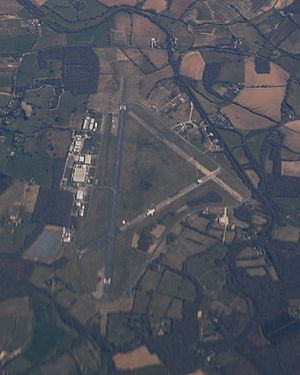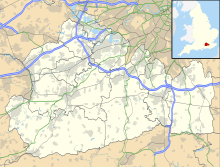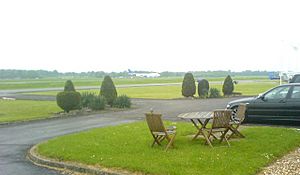Dunsfold Aerodrome facts for kids
Quick facts for kids
Dunsfold Aerodrome
|
|||||||||||||||||||
|---|---|---|---|---|---|---|---|---|---|---|---|---|---|---|---|---|---|---|---|

Dunsfold Aerodrome from the air, in April 2013
|
|||||||||||||||||||
| Summary | |||||||||||||||||||
| Location | Dunsfold | ||||||||||||||||||
| Elevation AMSL | 170 ft / 52 m | ||||||||||||||||||
| Coordinates | 51°06′54″N 000°31′57″W / 51.11500°N 0.53250°W | ||||||||||||||||||
| Map | |||||||||||||||||||
| Runway | |||||||||||||||||||
|
|||||||||||||||||||
Dunsfold Aerodrome is an airfield in Surrey, England. It is close to the village of Cranleigh. The airfield spreads across land in the villages of Dunsfold and Alfold.
The Canadian Army and other builders created it during World War II. It was a special airfield for bomber planes. From 1942 to 1944, the Royal Canadian Air Force (RCAF) ran it. It was then known as Royal Canadian Air Force Station Dunsfold. Later, the Royal Air Force (RAF) took over, calling it RAF Dunsfold.
After the war, aircraft companies like Hawker Siddeley used the airfield. Its successor, British Aerospace, also used it.
From 2002 to 2020, Dunsfold Aerodrome was famous for being the main home of the BBC show Top Gear.
Contents
History
Building and Military Use
Canadian engineers were in charge of building the airfield. These projects usually took a year to finish. But this site was tricky because it had 200 acres of woodland. They had to clear all the trees first.
The Canadian engineers had big earth-moving machines from North America. They even used special tools to place explosives under trees. This helped them remove the trees very quickly. Because of this, the airfield was finished in just six months!
The first planes based here were Curtiss Tomahawks and North American Mustang Is. Later, Mitchell bombers also used the airfield. After that, planes like Spitfires, Typhoons, and Tempests were based at Dunsfold.
After World War II, the RAF stopped using Dunsfold in 1946. However, an airline called Skyways Ltd then used it. They flew planes like the Avro York and Douglas C-54 Skymaster. Skyways even helped with the Berlin Airlift, which delivered supplies by air. They also fixed up old RAF Spitfires and Hawker Hurricanes for other countries.
After the War
In 1950, The Hawker Aircraft Company took over the airfield. Dunsfold became well-known for developing the Hawker Hunter jet fighter. They also made some Sea Hawks and fixed up Sea Furies.
In 1960, Hawker Siddeley tested their Hawker P.1127 prototype here. This plane led to the Hawker Siddeley Harrier. The Harrier was special because it could take off and land vertically, like a helicopter! The final assembly of the Harrier and the Hawk trainer aircraft happened at Dunsfold.
Hawker Siddeley became part of British Aerospace in 1977. In 1999, British Aerospace announced that Dunsfold would close. The production of planes like the Hawk and Harrier had moved to other places. The famous Hawker P.1127 plane that was at the gate moved to Brooklands Museum.
The 21st Century
In 2002, BAE Systems (the company that followed British Aerospace) sold Dunsfold Aerodrome. It was bought by The Rutland Group, who created Dunsfold Park Ltd.
Since mid-2002, the BBC car show Top Gear has filmed at Dunsfold Park. They used a hangar as their studio. They also used parts of the runways and taxiways as their famous test track.
The track is also used for bicycle races in the summer. These races are part of a special series in the Surrey Cycle Racing League.
From 2005 to 2019, Dunsfold Park hosted Wings and Wheels. This was an annual air and motor show. It usually happened in late August. The airshow attracted over 25,000 visitors. It also raised lots of money for charities like Help for Heroes.
Dunsfold Park Ltd also organizes other fun events. These include a drive-in cinema and a concert called Strings & Wings.
In 2020, two more Boeing 747-400 planes joined another 747 at Dunsfold. These planes are used for filming movies and for training. One of them, G-BNLY, is special because it has a classic 1980s paint job.
Housing Plans
In 2006, the owners of Dunsfold Aerodrome suggested building a new town there. They planned for 2,600 homes, a school, health services, and good transport links. The idea was to create a very green and sustainable place to live.
In 2007, Dunsfold Park Ltd tried to get their plans chosen as an "eco-town" by the government. But in 2008, their proposal was not chosen. The government said it was too small, needing at least 5,000 homes for an eco-town.
In 2008, Dunsfold Park Limited asked the local council for permission to build the eco-settlement. Many local people and councils were against it. However, some groups, including Friends of the Earth, supported it. They thought it was a good idea for sustainable living. But the local council refused permission. In 2009, the government also rejected the plan.
Even though the owners still hope to build homes there, they are now focusing on the airfield's aviation use. The airfield is still used for flights. In 2016, permission was granted for 1,800 homes. If these homes are built, the Top Gear test track might be removed.
Memorial
A special memorial was put up near the Alfold Barn pub. It was paid for by people who wanted to remember the airfield's history. The memorial was unveiled on July 20, 1992. This was exactly 50 years after the first plane landed at Dunsfold. During the unveiling, a de Havilland Tiger Moth and a Lockheed P-3 Orion flew overhead.
Museum
There is a museum at Dunsfold Aerodrome. It has a collection of items from the airfield's World War II days. Volunteers run the museum, and it is open to the public on Wednesdays. A man named Reg Day, who served at Dunsfold in 1943–44, started the museum.
Incidents and Accidents
Sadly, there have been some accidents at Dunsfold Aerodrome.
On January 7, 1944, two RAF bombers crashed near Dunsfold after colliding.
On November 20, 1975, a Hawker Siddeley HS.125 plane was taking off. Birds hit the plane as it lifted into the air. The pilots tried to land, but the plane went off the runway. It hit a car on the nearby A281 road. All six people in the car died, and one person on the plane was hurt.
On July 2, 1986, Jim Hawkins, a test pilot for British Aerospace, died at Dunsfold. His British Aerospace Hawk 200 plane crashed into a field near the airfield.
On June 5, 1998, a Hawker Hunter plane crashed at Dunsfold before an airshow. The pilot, John Davies, was killed.
Appearances in Media
A Boeing 747-200 plane, named City of Birmingham, was bought by a company that provides planes for movies. It was moved to Dunsfold. This plane was used for filming the 2006 James Bond movie Casino Royale. Some scenes that looked like Miami International Airport were actually filmed at Dunsfold.
This 747 plane has also appeared in the background of many Top Gear episodes. In one episode, a JCB Fastrac tractor towed it. It was also pulled by a Volkswagen Touareg in a Fifth Gear episode. The plane has also been in other TV shows like Primeval and movies like RED 2.



